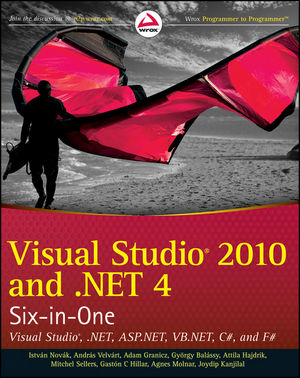Visual Studio 2010 and .NET 4 Six-in-One: Visual Studio, .NET, ASP.NET, VB.NET, C#, and F#ISBN: 978-0-470-49948-1
Paperback
1272 pages
October 2010
 This title is out-of-print and not currently available for purchase from this site.
|
INTRODUCTION xxxiii
PART I: VISUAL STUDIO
CHAPTER 1: HISTORY OF VISUAL STUDIO 3
Roots 4
Visual Studio.NET 2002 and 2003 5
Visual Studio 2005 7
Visual Studio 2008 8
Visual Studio 2010 10
Summary 13
CHAPTER 2: VISUAL STUDIO UI ENHANCEMENTS 15
Basic IDE Overview 15
Exploring New Daily Development Features 20
Exploring the Visual Designers 25
New Tools for Architects 27
Summary 29
CHAPTER 3: VISUAL STUDIO CODE SNIPPETS 31
Understanding Code Snippets 32
Creating Code Snippets 38
Managing Code Snippets 51
Advanced Code Snippet Features 56
Snippet Editors 59
Summary 63
CHAPTER 4: VISUAL STUDIO TEMPLATES 65
The Role of Templates 66
Creating Templates 70
Template Storage Structure 81
Customizing Templates 98
Deploying Templates 110
Summary 125
CHAPTER 5: GETTING THE MOST OUT OF THE IDE 127
Window Management 128
Customizing Menus and Toolbars 138
IDE Configuration 145
Reducing Efforts with Keyboard Shortcuts 155
Custom Start Pages 162
Customizing the Toolbox 186
Visual Studio Gallery 193
Summary 198
CHAPTER 6: VISUAL STUDIO EXTENSIBILITY 201
The Visual Studio Shell and Packages 202
Extensibility Out of the Box 204
Extensions with Visual Studio SDK 210
Creating Visual Studio Macros 213
Creating Visual Studio Add-Ins 229
Visual Studio Packages in a Nutshell 242
Extending the New Editor 255
Summary 275
PART II: .NET 4
CHAPTER 7: .NET FRAMEWORK VERSION HISTORY 279
Before the .NET Framework 279
The Origin and Goals of the .NET Framework 282
Evolution of the .NET Framework 283
.NET Framework Architecture 289
Main Benefits of the .NET Framework 293
Summary 294
CHAPTER 8: MODERN UI FRAMEWORKS (WPF AND SILVERLIGHT) 297
The Importance of User Experience 297
Developers Are from Vulcan, Designers Are from Venus 299
A New Generation of Presentation Frameworks 301
The Ten Pillars of Silverlight 303
Windows Presentation Foundation 359
Choosing Between WPF and Silverlight 366
Designer - Developer Cooperation in Silverlight and WPF 367
Summary 373
CHAPTER 9: WINDOWS COMMUNICATION FOUNDATION (WCF) 375
WCF Versus ASMX Web Services 375
A Quick Look at SOA 376
Building Blocks of the WCF Architecture 378
Getting Started With WCF 381
Working with an Ajax-Enabled WCF Service 392
REST and WCF 394
Implementing a WCF Service Declaratively 394
Summary 398
CHAPTER 10: ENHANCEMENTS TO THE .NET CORE FRAMEWORK 399
Changes in Common Language Run-time 400
Type Equivalence 411
Parallel Computing 415
Code Contracts 455
Managed Extensibility Framework 463
Summary 487
CHAPTER 11: ENHANCEMENTS TO THE .NET WORKFLOW FRAMEWORK 489
An Introduction to WF 4.0 490
Creating Flowcharts and Coded Workflows 499
Workflow Architecture 509
Workflow Activity Library 517
Using the Compensating Transaction Model 527
Persistence and Human Interactions 532
Workflow Services 551
Summary 562
CHAPTER 12: ENHANCEMENTS TO THE .NET DATA FRAMEWORK 563
Language Integrated Query (LINQ) 563
Parallel LINQ (PLINQ) 572
Entity Framework 573
The Entity Data Source Control 579
Choosing Between LINQ to Entities and LINQ to SQL 579
Summary 579
CHAPTER 13: ENHANCEMENTS TO THE .NET COMMUNICATION FRAMEWORK 581
Enhancements in WCF Framework 3.5 581
Enhancements in WCF Framework 4.0 583
Summary 592
CHAPTER 14: .NET CHARTING COMPONENTS 593
Creating Charts 594
Using Chart Controls 605
Advanced Chart Manipulation 633
Summary 649
PART III: ASP.NET 4.0
CHAPTER 15: ASP.NET VERSION HISTORY 653
Development of the Web and Web Development 653
Enter ASP 654
Enter ASP.NET 655
ASP.NET Version History 657
Summary 668
CHAPTER 16: ASP.NET CHARTING CONTROLS 669
Creating Charts 670
Rendering ASP.NET Charts 679
Chart State Management 688
User Interactivity 694
Summary 709
CHAPTER 17: ASP.NET DYNAMIC DATA 711
Creating a New Dynamic Data Web Site 711
Working to Modify Implementation to Fit Business Needs 730
Summary 750
CHAPTER 18: ASP.NET MODEL VIEW CONTROLLER (MVC) 751
Introduction to MVC 752
Creating an MVC 2 Application 761
Adding New MVC 2 Pages 771
Customization in MVC 2 790
Routing Details 816
Testing with MVC 2 824
A Few More Points on MVC 2 834
Summary 835
CHAPTER 19: ASP.NET AJAX IMPROVEMENTS 837
Understanding Ajax 838
Using the ASP.NET Ajax Server Controls 841
Using the Microsoft Ajax Library 848
Summary 892
CHAPTER 20: ASP.NET AJAX CONTROL TOOLKIT AND JQUERY 893
First Look at the Ajax Control Toolkit 894
Using the Controls of the Toolkit 908
The jQuery Library 962
Summary 977
CHAPTER 21: HISTORY OF VISUAL BASIC 981
The Roots of Visual Basic 982
Visual Basic in the .NET Framework 986
Summary 1005
CHAPTER 22: VISUAL BASIC 10.0 LANGUAGE IMPROVEMENTS 1007
New Productivity-Improving Syntax 1008
Working with Dynamic Objects 1020
Variance 1026
Summary 1038
CHAPTER 23: HISTORY OF C# 1041
The Evolution of C# 1041
C# 1.0 1044
C# 2.0 1047
C# 3.0 1056
Summary 1064
CHAPTER 24: C# 4.0 LANGUAGE IMPROVEMENTS 1065
Pains with Interoperability 1066
Dynamic Lookup 1072
Named and Optional Parameters 1078
COM-Specific Interoperability Features 1084
Variance 1087
Summary 1099
PART VI: F#
CHAPTER 25: VISUAL F# AND THE OTHER .NET LANGUAGES 1103
A Brief History of F# 1104
F# at First Glance 1105
Your First F# Project 1112
Programming with F# 1113
A Larger Application in F# 1163
Other .NET Languages 1170
Summary 1171
INDEX 1173



